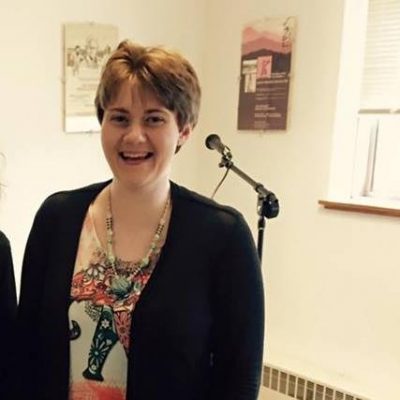 Their Bones Remember Water: A Fossil Poetry Collection
Their Bones Remember Water: A Fossil Poetry Collection
By Kelly Weber, Department of English. 1st place – Distinction in Creativity
Near the small town of Royal, Nebraska, Ashfall Fossil Beds State Historical Park is an ongoing excavation site where diggers reveal, without removing, some of the worlds best-preserved fossils within an ancient ash bed. My poetry collection Their Bones Remember Water comprises a series of intimate retrospective snapshots informed by my time working as a site interpreter at Ashfall. Combining research and Latin terminology with my own personal accounts and the fictionalized stories of people who visited the site, this sequence of poems mediates on the philosophical implications of the skeletons and humans place in history.
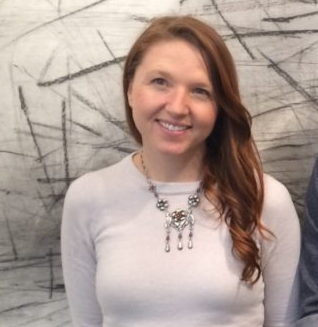 Life Chart
Life Chart
By Cedar Brant,Department of English. 2nd Place – Distinction in Creativity
Both Science and poetry are organizational nets that I place over the erratic natural and emotional worlds and being to track patterns, growth and unlikely relationships. I explore idea of home in relation to landscape in small, personal ways, and in an increasingly global way. How does the increasing field of vision necessary to address the global impacts of our politics, consumption, and growth impact of our complex sense of home? I seek to work at the intersection of language, science and imagination to explore these shifts in scope personally, communally and globally.
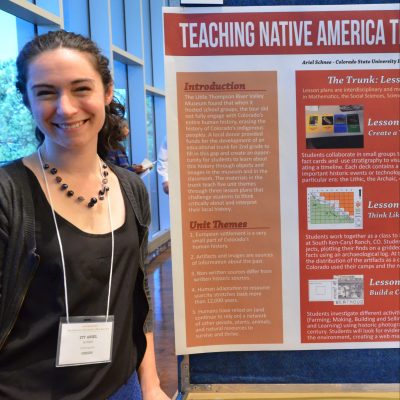
Teaching Native America: Developing a Local History Education Trunk
By Ariel Schnee, Department of History. Honorable Mention – Great Minds in Research
Native American history is often overlooked in small local history museums in the West. The Little Thompson Valley Pioneer Museum recognized this issue in their tours and developed a unit in a box consisting of three lesson plans. The educational trunk fills a gap in the historical narrative while meeting Colorado state academic standards and applying current education theory. The trunk uses interactive activities and artifacts to challenge young elementary students (2nd to 3rd grade) to think in sophisticated ways about Colorado’s Indigenous people from prehistory of Western Settlement
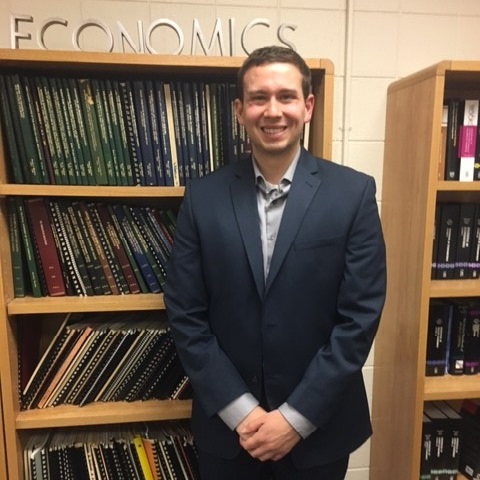 Regional Characteristics of the Difference Between Compensation and Productivity
Regional Characteristics of the Difference Between Compensation and Productivity
By Christopher Blake, Department of Economics. Honorable Mention – Great Minds in Research
What regional elements exist in the relationship between the compensation workers receive and their productivity? I analyze estimates of average compensation and labor productivity for four key sectors in the economy. This comparison shows that the relationship between compensation and productivity supports the amenity literature. Namely, workers are willing to receive lower compensation than their productive contributions if the region has relatively high amenities and workers necessitate compensation boosts above productivity to live in less desirable areas.
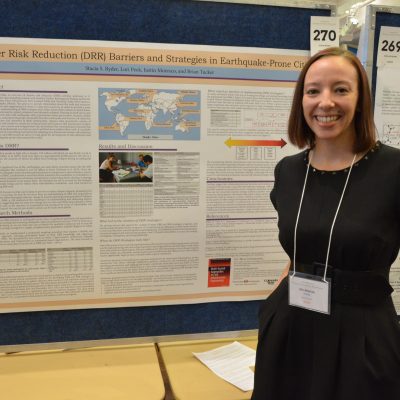
Barriers and Strategies for Disaster Risk Reduction in Earthquake-Prone Cities
By Stacia Ryder, Department of Sociology. Global Impact Research Award
This poster provides an overview of (1) barriers to disaster risk reduction (DRR) and (2) strategies for reducing disaster risk in 11 earthquake-prone cities including Antakya and Istanbul, Turkey; Bandung and Padang, Indonesia; Chincha and Lima, Peru; Christchurch, New Zealand; Delhi and Guwahati, India; San Francisco, USA; and Thimphu, Bhutan. The goal is to provide information about the different barriers to implementing DRR and to describe the tools and resources that practitioners and organizations in these 11 cities have access to. The poster offers practical advice to help guide the development of risk reduction tools for use in earthquake-prone cities worldwide.
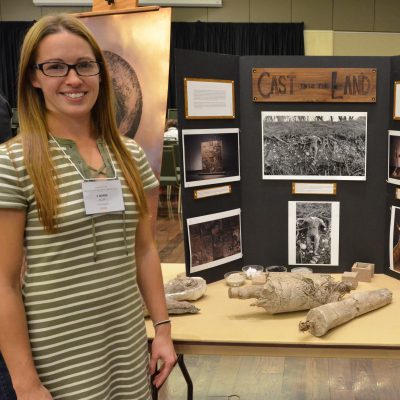
Cast Into the Land
By Sonja Allen, Department of Art and Art History. Top Scholar – New Graduate Student Award
I am a student in the Visual Arts Departments disciplining in sculpture. My interests lie in the possibility of reconnecting with natural through art that is created outside of a gallery and using organic materials found on-site. The location of the works is significant, because it signifies areas that have been modified by human efforts. I postulate over how this has changed throughout human history, especially now in this age of technology. I would like viewers to wander upon these forms and contemplate their own footprints on the land.
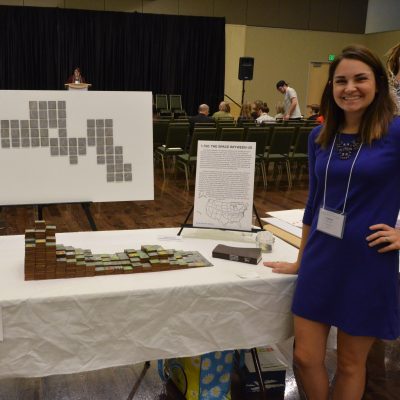
The Space Between Us
By Emily Sullivan, Department of Art and Art History. Top Scholar – Undergraduate Choice Award
The Space Between Us explores distance both literally and symbolically. Each of the 1,722 miles separating my husband and I are represented as small square tile. The tiles are presented in varied stacks showing the weight of this separation. On each, I painted a place growing in the regions between Colorado and North Carolina. In reality, the distance exists on the ground, where plants grow and make up each mile. I want to know the plants by their names, and to start piecing together their individual and collective stories. Despite the distance, there is thriving life between us.
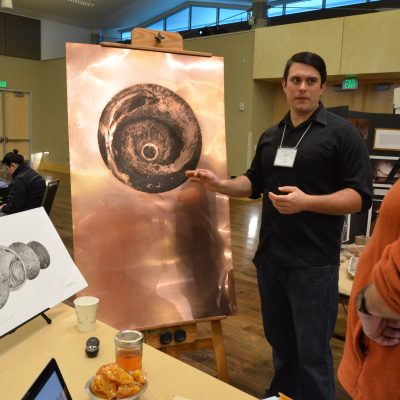
New Methods in Intaglio Printmaking
By Andrew Meyer, Department of Art and Art History. Highest Achievement in Creative and Performing Arts – College of Liberal Arts Award
This body of work is an attempt to advance the technical application of Intaglio printmaking. Throughout history the ability to creates a mark upon a matrix within Intaglio printmaking has been constantly evolving. The medium allows for a variety of techniques to be used to create a desired image etched or engraved into a metal plate. This body of research presents a brand new method of ‘mark-making’ in which the reaction of water to a copper plate coated with liquid rosin builds a new type of resist.
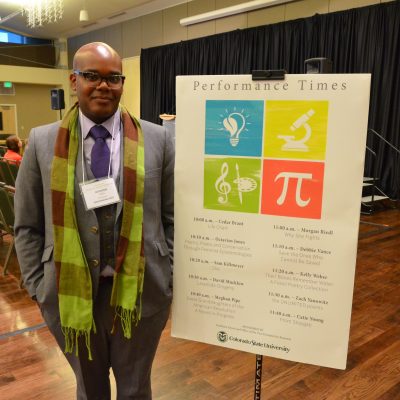
Poetry, Praxis and Conservation Through Feminist Epistemologies
By Octavius Jones, Department of Ethnic Studies. Highest Achievement in Creative and Performing Arts – College of Liberal Arts Award
The realities that climate change, ecosystem degradation and environmental pollution affect the livelihoods of all people today and all future generations within the biosphere brings an urgency to my work as there is no longer any time left for certain populations within humanity to remain hermeneutically ignorant and refuse to utilize the knowledge of Indigenous people. My research, through the use of poetry and the creative arts, seeks to elucidate the way in which African Feminist Epistemologies and Indigenous methodologies centered on love can prove a new path of solidarity and local autonomy for Indigenous.
 Graduate Students: The Key to Success in Interdisciplinary Research
Graduate Students: The Key to Success in Interdisciplinary Research
By Hannah Love, Department of Sociology. Highest Achievement in Scholarship/Research – College of Liberal Arts Award
To solve many of the wicked problems now facing our world, scientists will need to work in an interdisciplinary fashion to combine and transform knowledge. However, working with other scientific disciplines presents many challenges. For almost two-years I have studied eight interdisciplinary research teams at Colorado State University. Our research has found that often graduate students are the members of scientific team who bridge academic silos. This presents a problem because graduate students are frequently left out of arenas where faculty create and transfer knowledge. Therefore, we have developed a model to better incorporate graduate students into interdisciplinary research.

The Potosi-Cobjia Route: Archaeology of European Extractivism in the Andes
by Francisco Garcia Albarido Guede, Department of Anthropology. Highest Achievement in Scholarship/Research – College of Liberal Arts Award
Potosi (Bolivia) has been one of the most important sources of minerals exploited by European nations throughout history. Focusing on archaeological and historic information about the road that connected Potosi with the port of Cobija, Colonial and early Republican transportation is analyzed, providing a new insight into this important aspect of European extractivism in the Andes. This route, by which resources were moved to the Pacific and onward to Europe, was investigated using a mixture of strategies including remote sensing, archaeological inspection and historiographical review.
